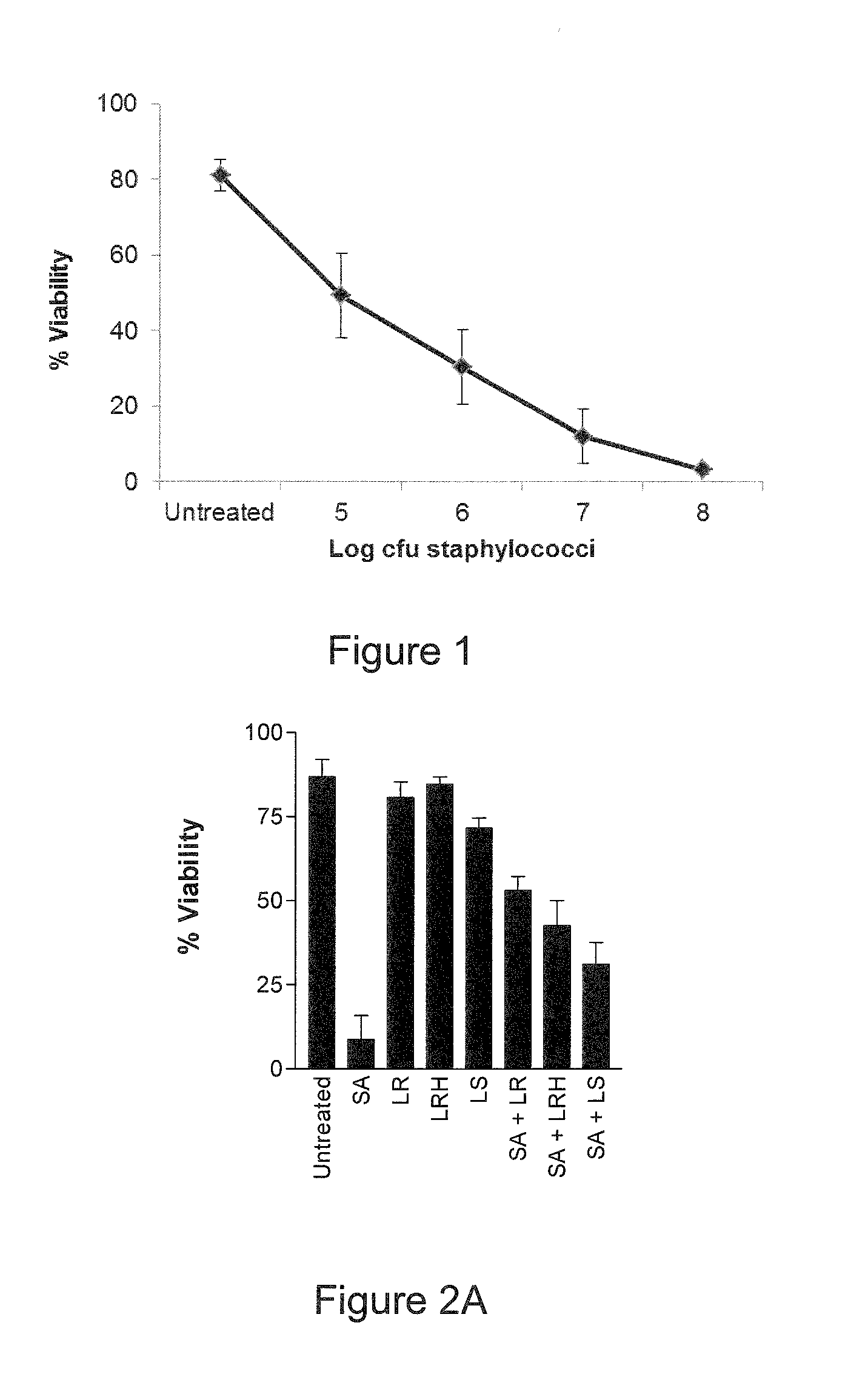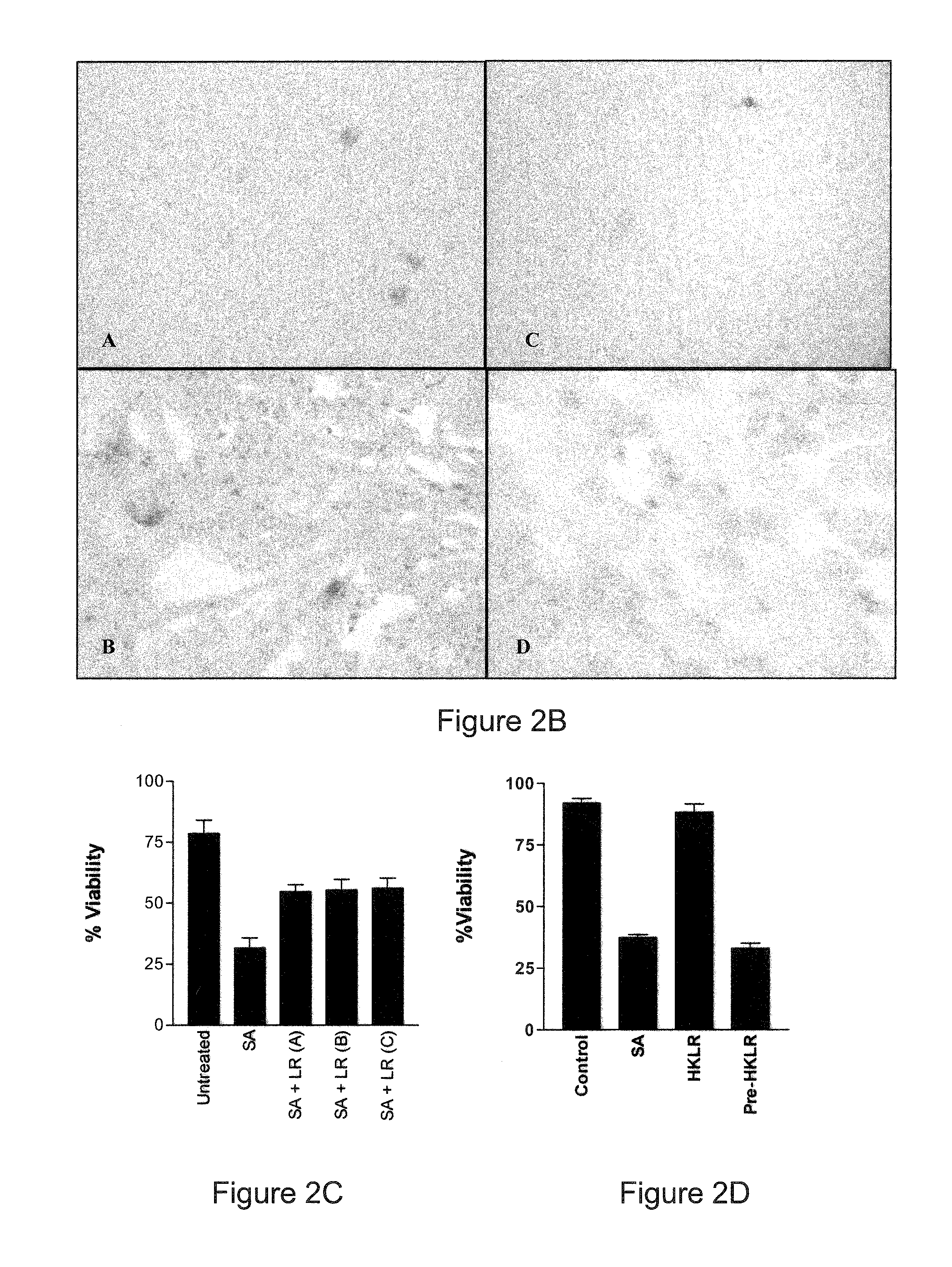Probiotic bacteria
a technology of probiotic bacteria and claudin, which is applied in the field of probiotic bacteria, can solve the problems of causing the loss of claudin 1, and affecting the survival of skin commensal bacteria, and achieves the effects of preventing a reduction of the barrier, preventing the loss of claudin 1, and reducing the prevalence of eczema
- Summary
- Abstract
- Description
- Claims
- Application Information
AI Technical Summary
Benefits of technology
Problems solved by technology
Method used
Image
Examples
example 1
Materials and Methods
Growth of Bacteria
[0131]Probiotic bacteria were grown routinely to stationary phase in Wilkins-Chalgren Broth (WCB) (Oxoid) at 37° C. in a Mark 3 Anaerobic Work Station (Don Whitley Scientific, Shipley, UK). S. aureus was grown aerobically with at 37° C. in Nutrient Broth (Oxoid). Culture densities were adjusted spectrophotometrically with medium to contain the number of bacteria required. For experiments utilising keratinocytes, bacteria were washed twice in 0.85% NaCl solution, centrifuged and reconstituted in keratinocyte medium. Selective agar was used in some experiments. This was Mannitol Salt Agar—MSA (Oxoid) or Man-Rogosa Sharpe agar (MRS) for S. aureus or Lactobacilli respectively. For experiments utilising heat killed bacteria, L. reuteri was centrifuged and resuspended in 0.4% glucose and heat inactivated by placing in a water bath at 85° C. for 45 minutes. Samples were gram stained to ensure lysis of bacterial cells had not occurred, and plated onto ...
example 2
S. aureus Induced Cell Death in Primary Human Keratinocytes
[0139]We initially characterised the effects of S. aureus on keratinocyte viability by performing trypan blue exclusion assays on NHEK incubated with S. aureus at different doses. At a concentration of 105 cfu / ml S. aureus, only 49.4% of keratinocytes were viable after 24 hours infection (FIG. 1). This was reduced in a dose dependent manner such that only 3.3% of keratinocytes were viable at concentrations of 108 cfu / ml S. aureus (FIG. 1). Approximately 106 organisms is a physiologically relevant concentration that might be found e.g. in a skin wound infection (7). At this concentration, 30.5% of keratinocytes were viable after 24 hours infection. This concentration was used in adhesion assays.
L. reuteri Protects Keratinocytes from S. aureus Induced Cell Death
[0140]The ability of three strains of lactobacilli (L. reuteri ATCC 55730, L. rhamnosus AC413 and L. salivarius UCC118) to protect keratinocytes from the effects of S. ...
example 3
[0157]As set out above, we demonstrated that Lactobacillus reuteri can partially protect primary human keratinocytes from the effects of the skin pathogen, Staphylococcus aureus. In this study, to further our understanding of the potential of probiotics, we have evaluated the role of a second probiotic, L. rhamnosus GG as well as combinations of lactobacilli, and bacterial lysates in the inhibition of S. aureus infection of keratinocytes. L. rhamnosus GG was isolated from human faeces (see U.S. Pat. No. 4,839,281 and U.S. Pat. No. 5,032,399), and is deposited under accession number ATCC 53103.
L. reuteri Protects Keratinocytes from S. aureus Induced Cell Death
[0158]Normal human primary keratinocytes (KCs) were exposed to S. aureus (106 / ml) in the presence or absence of L. rhamnosus GG, L reuteri either alone or in combination (all at 108 / ml). The viability of the KCs was measured after 24 hours using a trypan blue exclusion assay.
[0159]When KCs were treated with S. aureus alone, only...
PUM
 Login to View More
Login to View More Abstract
Description
Claims
Application Information
 Login to View More
Login to View More - R&D
- Intellectual Property
- Life Sciences
- Materials
- Tech Scout
- Unparalleled Data Quality
- Higher Quality Content
- 60% Fewer Hallucinations
Browse by: Latest US Patents, China's latest patents, Technical Efficacy Thesaurus, Application Domain, Technology Topic, Popular Technical Reports.
© 2025 PatSnap. All rights reserved.Legal|Privacy policy|Modern Slavery Act Transparency Statement|Sitemap|About US| Contact US: help@patsnap.com



